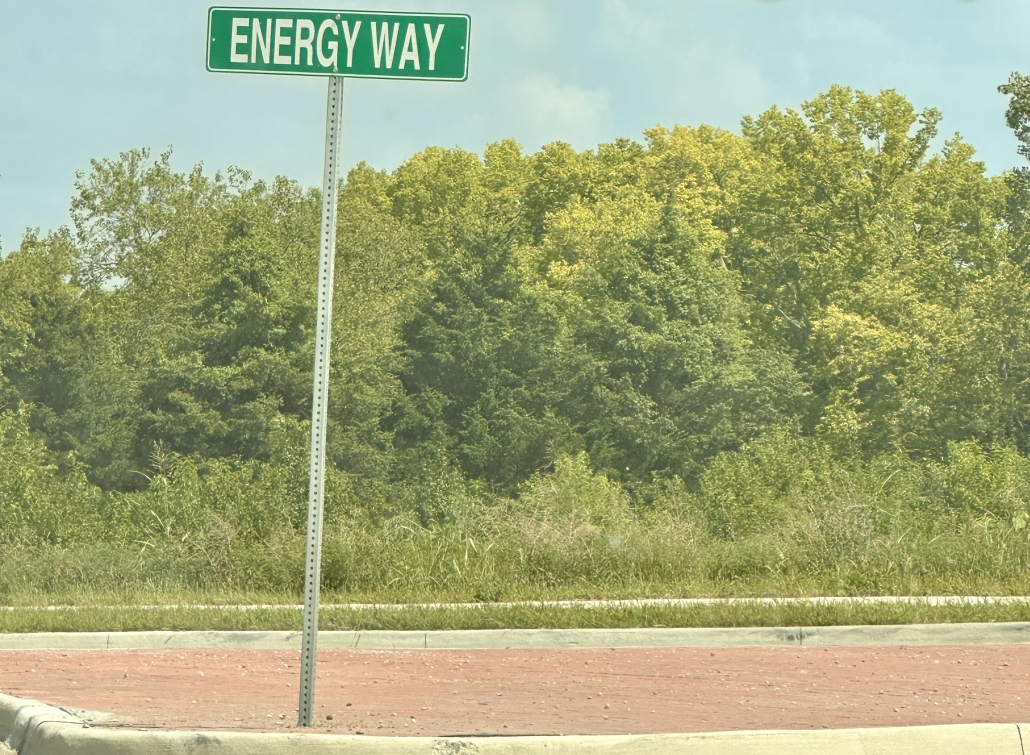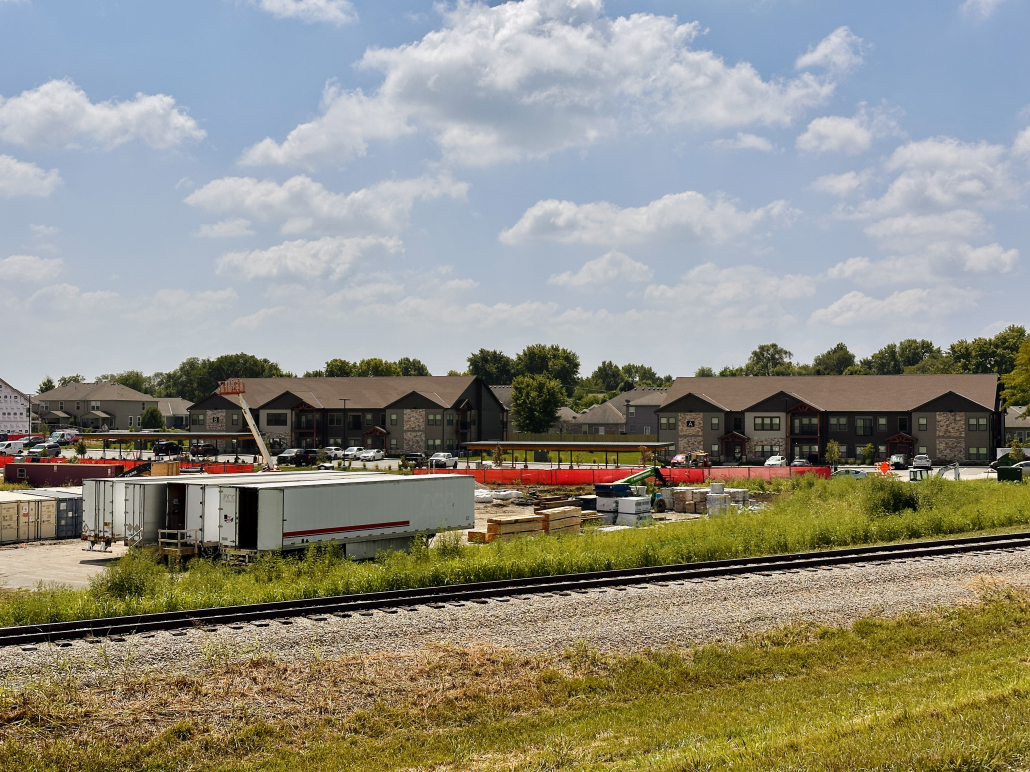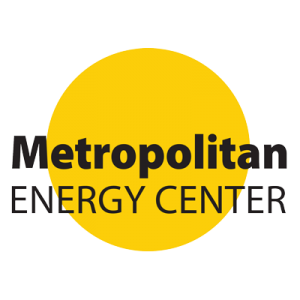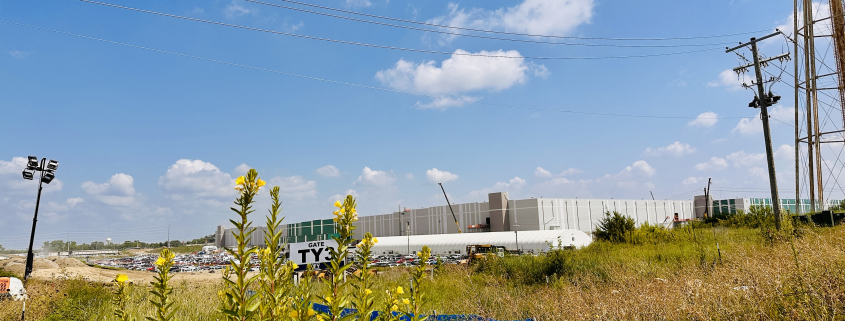De Soto on the Rise: A Small Town’s Big Leap Toward Sustainable Growth
By Kasi Darnell, Drew Arends and Layne Stracener
The hum of progress is getting louder on the outskirts of De Soto, Kansas.
Once a quiet town nestled along the Kansas River, De Soto now finds itself at the epicenter of the largest economic development project in Kansas history: Panasonic’s $4 billion electric vehicle battery plant.
Panasonic recently hosted the grand opening of the massive facility. But almost as quickly as the ribbon was cut, the company announced it would delay full-scale production, citing declining electric vehicle (EV) sales and U.S. policies that do not support EVs.
With promises of thousands of jobs, billions in investment and a surge of new residents, De Soto is on the edge of extraordinary change. Yet the central question remains: will this growth be sustainable?
A New Frontier

Follow Energy Way straight into the future of De Soto, where innovation meets community.
On the edge of town, the new Astra Enterprise Park facility looms large—literally. When complete, the sprawling plant will cover 300 acres, big enough to fit more than 225 football fields. Panasonic expects the plant to boost its global battery production capacity by 60 percent, making De Soto a key node in the world’s transition to electric vehicles.
City leaders anticipate ripple effects. A $2 million investment in planned road improvements could generate an estimated $400 million in infrastructure, education and community benefits over the next 20 years, according to the City of De Soto’s website.
The challenge is ensuring those benefits are broadly shared—and built to last. The lithium-ion battery plant represents more than local development. It has the potential to transform De Soto’s identity while accelerating the global shift to clean energy.
A Town In Transition
On Main Street, the pace of change is felt in the everyday rhythms of small-town life.
At Cause Coffee, the low hum of conversation mingles with the distant rumble of construction—a fitting soundtrack for a town on the edge of transformation. Repurposed from a historic house, the café has become more than just a place to grab a drink. It’s a central hub where longtime locals and newcomers share space, stories and a cautious optimism about the future.
Some expressed hope. Others voiced concern. But nearly all shared an awareness that De Soto is changing—and quickly.
“I think it’s good,” said one woman who has lived in De Soto for nine years. “But I think it’s going to change our town. What happens to small town life?”
Other residents shared similar apprehension to what the development means for the community, citing the dramatic increase in housing developments, foreign investment and low-paying jobs as downsides to the project.
One small business owner said contracts have been hard for local firms to secure.
“I can’t bid against the unions that have over 5,000 people,” he said. “Yes, some are from the Kansas City area, but there has not been as much investment into the community as was promised.”
Opinions ranged from fears of a “trainwreck” to cautious optimism, but most agreed the outcome could go in many directions.
Just across the street, the transformation of the Johnson County Library De Soto Branch mirrors De Soto’s own. The building closed in September for a remodel and will reopen in spring 2026. It’s a “happy coincidence” that the major update aligns with other developments in town, said Julia Vanderwerff, a clerk who works part-time at the branch.
Vanderwerff cited a noticeable uptick in library cards, with new families coming in and new cards being printed “at least a couple of times a week.” As new families arrive and longtime residents adapt, De Soto’s institutions are rising to meet the moment. It’s a reminder that sustainable growth isn’t only about infrastructure or industry—it’s about people and the public places that bring them together. The library continues to serve as a critical “third space”—a neutral ground where all people, regardless of income, background or how long they’ve lived in town, can feel welcome.
And that’s where the heart of the sustainability question lies. Because growth—no matter how green or well-branded—is only truly sustainable when it accounts for everyone. That means the longtime residents, small business owners, hourly workers and people whose day-to-day lives will be shaped by what’s being built. If development doesn’t reflect their needs and realities, it risks becoming just another missed opportunity.
Promising Growth
The De Soto Chamber of Commerce sees opportunity in the rapid changes.
Tim Holverson, president of the De Soto Chamber of Commerce and Economic Development Council, said the Chamber is enthusiastic about community growth but mindful of the need to “protect, preserve and enhance existing infrastructure along Main Street.” He pointed to an 88 percent increase in sales tax receipts, evidence of rising economic activity and stronger local business performance.
“People are coming because of what is here but also the promise of what’s coming.” Holverson said.
The Chamber is actively recruiting new businesses and industries to De Soto.

New apartment construction near Astra Enterprise Park as De Soto experiences rapid development.
“There’s one I would love to tell you about,” Holverson teased, hinting at future announcements.
Still, Holverson acknowledged that rapid growth comes with challenges. Astra Enterprise Park, once the site of an ammunition factory, has required extensive remediation to prepare for redevelopment. Housing is a particular pressure point. With a vacancy rate of just 1.6 percent— “stupidly, ridiculously low,” as Holverson puts it—the city faces a crunch. While thousands of apartments and single-family homes are under construction, concerns remain about affordability and the risk of rising property taxes pushing out longtime residents.
This summer, Panasonic surpassed its hiring goal of 1,000 employees by about 100. A massive solar farm is slated for development nearby, and the city’s water treatment facility has been upgraded to an 8-million-gallon capacity.
Whether welcomed or met with concern, growth is inevitable. The question is how—and whether—it will be sustainable.
Growth at Astra Enterprise Park
Panasonic officials said they believe Astra Enterprise Park can deliver immense economic benefits—and do so sustainably. The company has pledged to source 100 percent local renewable energy for Astra Enterprise Park within 10 years and reduce environmental impact across its supply chain.
“As a producer of automotive batteries for EVs, Panasonic has a responsibility to be a pioneer in the fight against climate change,” an article on Panasonic’s website states.
But sustainability is more than just corporate commitments or kilowatt-hours saved. It’s whether families can afford to stay in their homes. It’s whether small businesses can thrive alongside global corporations. It’s whether development builds resilience—social, economic and environmental—for generations to come.
What’s Next?
At Metropolitan Energy Center (MEC), we believe growth can be sustainable if planned intentionally. For more than 40 years, MEC has worked at the intersection of energy, community health and economic vitality.
In places like De Soto, sustainable development means planning for homes that are not only affordable but also energy efficient. It means EV-ready infrastructure and clean transportation options that reduce pollution. It means retrofitting existing structures, supporting workforce development in the trades and ensuring longtime benefits for residents—not just newcomers or corporations.
MEC believes the City of De Soto and Panasonic have a unique opportunity to showcase what sustainability in a new frontier can look like. Imagine a city where new buildings are equipped with solar panels and heat pumps, weatherization features are built into every home and multi-modal transportation options help preserve the peaceful charm of a quiet river town without the disruption of excess traffic.
For Panasonic, picture a solar farm powering its massive infrastructure (which is in the works), a robust rideshare program bussing Kansas City-area employees to and from De Soto and electric vehicle chargers installed right outside the EV battery plant.
These ideas aren’t pipe dreams—they are tangible realities. As De Soto grows, we contend it has a responsibility to the community it serves to make sustainability a central part of its future.
As the Panasonic project advances, we’re here to support efforts that prioritize local workforce development, energy benchmarking and climate-smart growth policies—because sustainability isn’t just about new technology. It’s about people, systems and values.
MEC is home to a range of impactful programs—Building Performance, Energy Solutions Hub, Sustainable Transportation and Clean Cities—all of which have helped communities across Kansas and Missouri make the shift toward a more sustainable future—quietly, strategically and with long-term vision.
At MEC, we’re ready to be part of the conversation, offering tools, partnerships and perspective for a future that honors the past while building something smarter.
De Soto’s story is unfolding in real time—a crossroads of rural identity, economic ambition and environmental responsibility. As this small town takes a big leap, let’s make certain it lands on solid, sustainable ground.
Want to bring sustainability into your growing community? Connect with us at metroenergy.org or reach out to learn how MEC can support your city’s future. Contact Kasi, Drew, or Layne to learn more.


